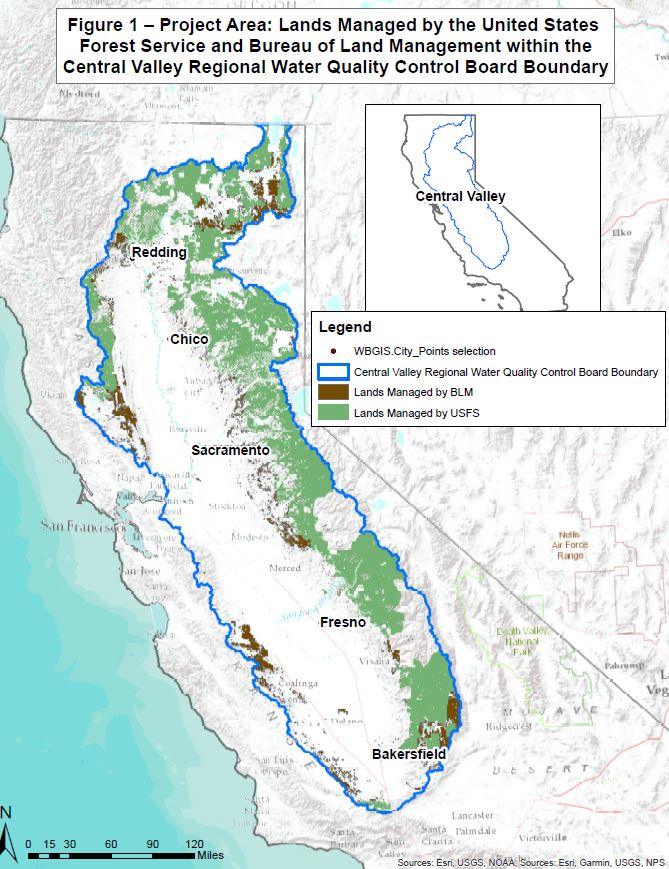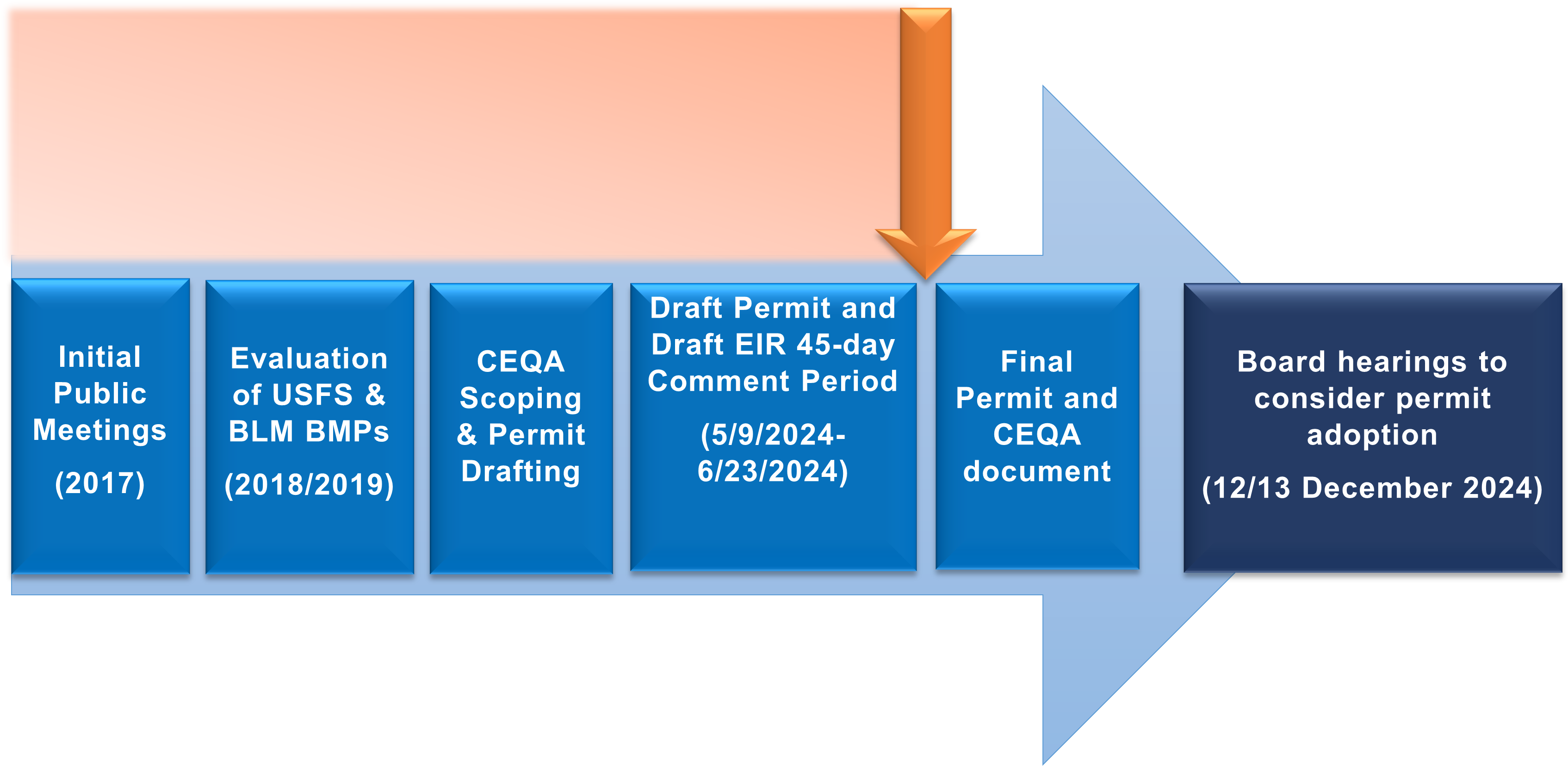Development of Nonpoint Source Permits for Federal Lands Managed by the United States Forest Service and Bureau of Land Management
Permit Overview
The Central Valley Regional Water Quality Control Board (Central Valley Water Board) in coordination with the United States Forest Service (USFS) and the Bureau of Land Management (BLM), is developing a nonpoint source (NPS) permit to ensure regulatory compliance and water quality protection for certain projects undertaken by the USFS and BLM on federally managed lands.
Up until August of 2021, the Lahontan Regional Water Quality Control Board (Lahontan Water Board) was also involved in the permit development project, however competing priorities led to the decision for the Lahontan Water Board to withdraw from the project. The Central Valley Water Board staff will continue with permit development activities and plans to present a draft permit for board consideration in early 2023. Please read on for more details.
Land management activities that may be regulated under the proposed NPS permit include timber harvest and vegetation management, transportation management, recreation facilities management, wildfire management and recovery, and restoration activities.
The scope of the proposed permit includes USFS and BLM managed lands within the Central Valley Water Board region, roughly 11 million acres.

Public Involvement and Notification
Central Valley Water Board - Notice of Preparation and California Environmental Quality Act Scoping Meeting
On April 13, 2021, the Central Valley Regional Water Quality Control Board (Central Valley Water Board) conducted a California Environmental Quality Act (CEQA) scoping meeting to solicit input regarding the scope and content of information to be included in the Environmental Impact Report (EIR) that will be prepared to assess the potential environmental effects of the proposed project, Waste Discharge Requirements for Nonpoint Source Discharges Related to Certain Activities Conducted by the Bureau of Land Management and United States Forest Service on Federal Lands (Federal NPS Permit). The Central Valley Water Board is the Lead Agency for the project.
- Notice of Preparation and CEQA Scoping Meeting
- Notice of Preparation and CEQA Scoping Meeting (Spanish)
- Notice of Preparation and CEQA Scoping Meeting (Hmong)
- Notice of Preparation and CEQA Scoping Meeting (Chinese)
- Notice of Preparation and CEQA Scoping Meeting (Tagalog)
Scoping Meeting Recording: The scoping meeting was held on April 13, 2021. Stakeholders can view a recording of the meeting on the State Water Board YouTube channel.
Comment Period: A 45-day public comment period was provided, from March 12, 2021 through April 27, 2021. For additional information, please contact Angela Wilson.
General Public Involvement
Throughout the permit development process there will be opportunities for public involvement and comment, including but not limited to: CEQA scoping, draft permit and environmental document circulation, and again at Water Board adoption hearings.
To receive project information and updates, including meeting announcements and draft documents, please sign up for notification via the Water Board’s List Serve. Fill in your email and name, check the Federal NPS Activities - Central Valley Regional Board box, and click submit. You will need to respond to a confirmation email to finalize the process.
In 2017, the Central Valley and Lahontan Water Boards held six outreach meetings to inform the public and gather initial feedback and concerns about the effort to develop permits to reduce and prevent NPS pollution from activities on lands managed by the USFS and BLM. Meeting information including summaries of comments received can be found at:
Permit Development Work
Central Valley Water Board staff are working closely with leadership and field office staff of the USFS and BLM. Staff presented information on the proposed permits to both BLM and USFS leadership at their respective quarterly leadership meetings in June and September 2018.
During 2018 and 2019, staff conducted field visits with USFS and BLM representatives to evaluate best management practices (BMPs) used to protect water quality. The evaluations were conducted to view projects and on-going land management activities with the goal of better understanding the various BMPs, monitoring programs, and management processes undertaken by each agency. How the federal agencies develop, implement, monitor, and maintain BMPs, and how management is adapted is a critical piece of permit development.
Both the USFS and the BLM have voluntarily compiled new or supplementary BMP guidance for implementation on federal lands in California as a result of this process. These BMPs are expected to be implemented beginning in 2021.
Permit Development Timeline

What is NPS pollution?
Unlike direct discharges of waste from point source pollution sources (e.g., municipal wastewater treatment), NPS pollution may originate from multiple sources—such as roads, agricultural areas, forests and other features of the landscape—and is transported by rainfall, snowmelt, and irrigation water to many types of waterbodies. This diffuse runoff has the potential to carry both naturally occurring and human-originated pollutants into drainage ditches, lakes, rivers, wetlands, bays, and aquifers. Common contaminants and sources associated with NPS runoff can include: nutrients, pesticides and pathogens that may originate from agricultural and vegetation management activities, grazing, and dairies; fertilizers, metals, and petroleum products in stormwater runoff from urban areas; and sediment originating from erosion associated with timber harvesting activities, construction sites, and roads.
Activities Proposed for Permit Coverage
Example activities being considered for the Proposed Permit include:
- Vegetation Management: Management of vegetation can improve forest health, reduce fuel loading, and allow harvest of commercial timber. Such activities can result in soil disturbance, modification of hillslope drainage patterns, and erosion.
- Transportation Management: Without proper design and maintenance, all phases of road and trail management—including construction, road use, maintenance, reconstruction, upgrades, and decommissioning—can lead to sediment-related nonpoint source pollution. Roads and trails can cause disruptions in hillslope drainage patterns, slope instability, and erosion.
- Recreational Facilities Management: Recreation activities can generate potential discharges of sediment, nutrients, and bacteria to watercourses, as well as result in the alteration of aquatic or riparian habitat. Facilities of concern include areas such as campgrounds, trail heads and staging areas, high use recreation sites, recreational event locations, and shooting areas.
- Wildfire Management & Recovery: Activities conducted as part of fire suppression repair, emergency post-fire recovery, and long-term post-fire recovery may include erosion control, timber salvage, hazard tree removal, revegetation activities and related pesticide application.
- Restoration Activities: Restoration activities are often designed to improve habitat, prevent water quality and/or instream habitat degradation, and reduce legacy or chronic erosion and sedimentation. Restoration projects may include watercourse crossing improvement, channel and bank stabilization, stream channel and floodplain habitat enhancement, and meadow restoration.
Please note that the permit development process may identify additional activities that warrant consideration.
Regulatory Nexus
The Porter-Cologne Water Quality Control Act (Porter-Cologne Act) designates the State and Regional Water Boards as the agencies within the State of California with the primary responsibility for protecting water quality in California. The Porter-Cologne Act obligates the Water Boards to address all discharges of waste (pollution) that could affect the quality of waters of the state, including potential sources of NPS pollution. Section 319 of the federal Clean Water Act requires states to develop a management plan to address NPS pollution. In 2004, California met this requirement with its Policy for the Implementation and Enforcement of the Nonpoint Source Pollution Control Program (NPS Policy). The NPS Policy requires the Water Boards to address potential NPS pollution issues through the issuance of waste discharge requirements, conditional waivers of waste discharge requirements and/or basin plan prohibitions. Together, the Porter-Cologne Act and the Clean Water Act require the Water Boards to address activities with the potential to cause NPS pollution on federal lands within their respective jurisdictions.
Available Documents
Contact Information
The Central Valley Water Board maintains an email list for this project, please direct questions and comments to: RB5R-Fed.NPS.permit@Waterboards.ca.gov or you may contact our staff directly.
Central Valley Water Board Project Contacts:
- Griffin Perea, Senior Engineering Geologist
Griffin.Perea@waterboards.ca.gov - Angela Wilson
Angela.wilson@waterboards.ca.gov
Supervising Engineering Geologist



